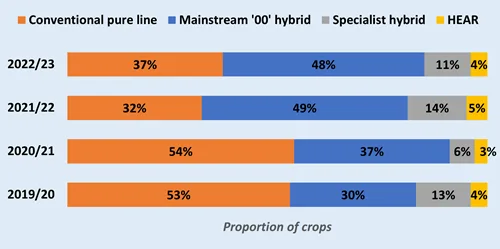Published on 27th June 2022
Seed & Establishment
Key OSR growing advantages highlighted in benchmarking study

Robust hybrids have dealt with the past season’s more challenging winter OSR conditions better than other varieties, reveals Bayer’s latest annual Dekalb benchmarking with over 150 UK growers almost 20,000ha of 2022/23 plantings.
Key OSR growing advantages highlighted in benchmarking study
Robust hybrids have dealt with the past season’s more challenging winter OSR conditions better than other varieties, reveals Bayer’s latest annual Dekalb benchmarking with over 150 UK growers almost 20,000ha of 2022/23 plantings.
The marked shift toward hybrid growing recorded in the three years of previous studies continues to be evident this season, with almost half the main varieties in the ground being mainstream double low (‘00’) hybrids and only a third conventionally bred pure-lines
(Figure 1).
Figure 1: Main Variety Types (2019/20 – 2022/23)

And this trend is with good reason. Even though local pressures meant a generally higher CSFB challenge last autumn for those favouring hybrids over pure line varieties, they actually saw lower average larval levels, higher mid-February GAIs and better cop condition before flowering.
“Underling the value of the most robust hybrids, those with Dekalb Ex hybrids as their main varieties had an even better average crop performance in every respect,” points out Bayer seed commercial manager, Sarah Bebb (Figure 2).
“As a result, Dekalb Ex growers are taking 94% of their plantings to harvest, against 88% for hybrid growers overall and just 80% for those preferring pure lines.
Figure 2: Crop Success by Main Variety Type (2022/23)

* Crop establishment(0=crop lost:10= perfect establishment)
Larval level (0=no larvae or scar: 10=more than 30 larvae/plant or multiple scars on all petioles & stems)
GAI (Actual score) Crop condition (0=very poor: 10=excellent)
“As well as less damage from CSFB larvae, noticeably fewer of our hybrid growers reported serious winter weather plants losses and pigeon damage than pure-line growers,” she adds.
“The hybrid crop survival advantage has been especially marked where autumn pest levels proved the most challenging. Indeed, fully 81% of hybrid growers’ crops suffering intense or substantial CSFB pressures are being taken to harvest. This compares with just 55% for those favouring pure lines.”
Successful Grower Practices
Hybrid growing is understandably more popular among those averaging 4.5t/ha or more last season and expecting to at least match this in 2023 than it is for those averaging 3.5t/ha in 2022 and not expecting to exceed it this harvest.
Interestingly, both groups of growers are putting similar emphasis on reducing OSR frequency in the rotation; choosing vigorous fast-developing varieties; seedbed fertilisation; spreading organic manures; and, basing nitrogen applications closely on crop GAI.
Markedly more of the most successful growers are, however, employing seven particular risk-reducing management practices. At the same time far fewer are using farm-saved seed (Figure 3).
Figure 3: Crop Performance Level and Key Management Practice Differences (2022/23)
“Geography and individual farm conditions clearly have an influence on the performance differences,” Ms Bebb observes. “While growers in both groups are adopting a number of important modern-day management practices, though, those achieving the greatest success are putting considerably more emphasis on a few additional management essentials as well as favouring hybrids to a noticeably greater extent.
“This underlines the even greater importance of attention to detail in OSR production today.
“Quite simply, if you’re growing the crop you need to choose the most robust varieties and manage them as well as you possibly can. There really is no room for half measures.”


